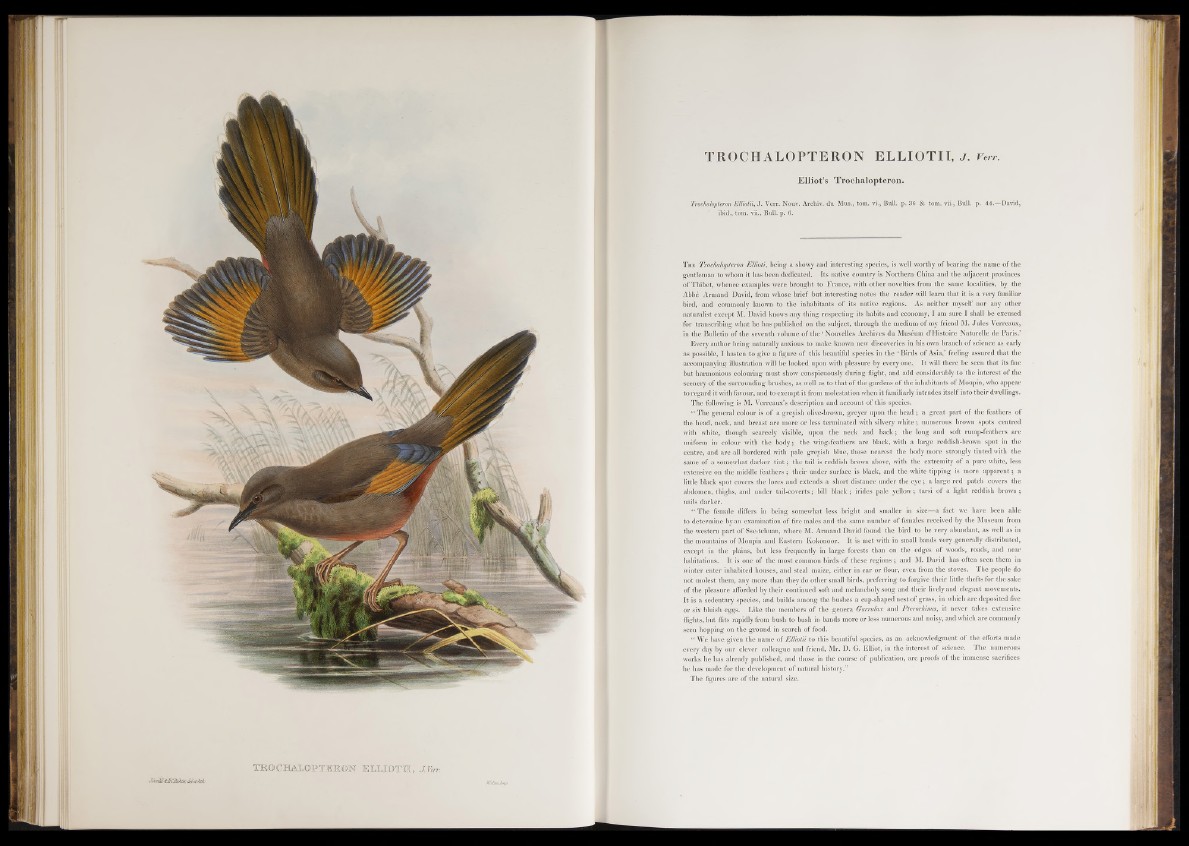
JCvuM/AffCRichta; äd'Cbhth/.
TROCHALOPTERON' E L L IO T II, J.Jerr.
JftdOr.inp.
TROCHALOPTERON ELLIOTI I , J . Verr.
Elliot’s Troclialopteron.
Trochalopteron Elliotii, J. Verr. Nouv. Archiv, du Mus., tom. vi., Bull. p. 36 & tom. vii., Bull. p. 44.—David,
ibid., tom. vii., Bull. p. 6.
T h e Trochalopteron Elliott, being a showy and interesting species, is well worthy o f bearing the name o f the
gentleman to whom it has been dedicated. Its native country is Northern China and the adjacent provinces
of Thibet, whence examples were brought to France, with other novelties from the same localities, by the
Abbé Armand David, from whose brief but interesting notes the reader will learn that it is a very familiar
bird, and commonly known to the inhabitants of its native regions. As neither myself nor any other
naturalist except M. David knows any thing respecting its habits and economy, I am sure I shall be excused
for transcribing what he has published on the subject, through the medium of my friend M. Jules Verreaux,
in the Bulletin of the seventh volume of the ‘ Nouvelles Archives du Muséum d’Histoire Naturelle de Paris.’
Every author being naturally anxious to make known new discoveries in his own branch o f science as early
as possible, I hasten to give a figure of this beautiful species in the ‘ Birds of Asia,’ feeling assured that the
accompanying illustration will be looked upon with pleasure by every one.. It will there be seen that its fine
but harmonious colouring must show conspicuously during flight, and add considerably to the interest of the
scenery of the surrounding brushes, as well as to that o f the gardens o f the inhabitants o f Moupin, who appear
to regard it with favour, and to exempt it from molestation when it familiarly intrudes itself into their dwellings.
The following is M. Verreaux’s description and account of this species.
“ The general colour is of a greyish olive-brown, greyer upon the head ; a great part of the feathers of
the head, neck, and breast are more or less terminated with silvery white ; numerous brown spots centred
with white, though scarcely visible, upon the neck and back ; the long and soft rump-feathers are
uniform in colour with the body ; the wing-feathers are black, with a large reddish-brown spot in the
centre, and are all bordered with pale greyish blue, those nearest the body more strongly tinted with the
same of a somewhat darker tint ; the tail is reddish brown above, with the extremity of a pure white, less
extensive on the middle feathers ; their under surface is black, and the white tipping is more apparent ; a
little black spot covers the lores and extends a short distance under the eye ; a large red patch covers the
abdomen, thighs, and under tail-coverts ; bill black ; irides pale yellow ; tarsi of a light reddish brown ;
nails darker.
“ The female differs in being somewhat less bright and smaller in size—a fact we have been able
to determine by an examination o f five males and the same number of females received by the Museum from
the western part of Sse-tchuan, where M. Armand David found the bird to be very abundant, as well as in
the mountains of Moupin and Eastern Kokonoor. It is met with in small bands very generally distributed,
except in the plains, but less frequently in large forests than on the edges of woods, roads, and near
habitations. It is one of the most common birds of these regions ; and M. David has often seen them in
winter enter inhabited houses, and steal maize, either in ear or flour, even from the stoves. The people do
not molest them, any more than they do other small birds, preferring to forgive their little thefts for the sake
of the pleasure afforded by their continued soft and melancholy song and their lively and elegant movements.
It is a sedentary species, and builds among the bushes a cup-shaped nest of grass, in which are deposited five
or six bluish eggs. Like the members of the genera Garrulax and Pterorhinus, it never takes extensive
flights, but flits rapidly from bush to bush in bands more or less numerous and noisy, and which are commonly
seen hopping on the ground in search of food.
“ We have given the name of Elliotii to this beautiful species, as an acknowledgment of the efforts made
every day by our clever colleague and friend, Mr. D. G. Elliot, in the interest of science. The numerous
works he has already published, and those in the course of publication, are proofs of the immense sacrifices
he has made for the development o f natural history.”
The figures are o f the natural size.